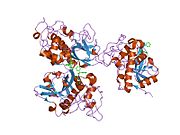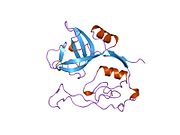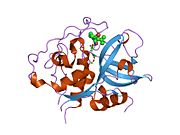Cathepsin B belongs to a family of lysosomal cysteine proteases known as the cysteine cathepsins and plays an important role in intracellular proteolysis. In humans, cathepsin B is encoded by the CTSB gene. Cathepsin B is upregulated in certain cancers, in pre-malignant lesions, and in various other pathological conditions.
Structure
Gene
The CTSB gene is located at chromosome 8p22, consisting of 13 exons. The promoter of CTSB gene contains a GC-rich region including many SP1 sites, which is similar to housekeeping genes. At least five transcript variants encoding the same protein have been found for this gene.
Protein
Cathepsin B is synthesized on the rough endoplasmic reticulum as a preproenzyme of 339 amino acids with a signal peptide of 17 amino acids. Procathepsin B of 43/46 kDa is then transported to the Golgi apparatus, where cathepsin B is formed. Mature cathepsin B is composed of a heavy chain of 25-26 kDa and a light chain of 5kDa, which are linked by a dimer of disulfide.
Function
Cathepsin B may enhance the activity of other proteases, including matrix metalloproteinase, urokinase (serine protease urokinase plasminogen activator), and cathepsin D, and thus it has an essential position for the proteolysis of extracellular matrix components, intercellular communication disruption, and reduced protease inhibitor expression.
Cells may become carcinogenic when cathepsin B is unregulated.
Potential in disease
Cathepsin B has been proposed as a potentially effective biomarker for a variety of cancers. Overexpression of cathepsin B is correlated with invasive and metastatic cancers.
Cathepsin B has been shown to be involved in the pathogenesis of pancreatitis, by prematurely activating the digestive enzyme trypsinogen within the pancreas, leading to autodigestion of acinar cells.
Interactions
Cathepsin B has been shown to interact with:
Cathepsin B is inhibited by:
See also
References
- ^ ENSG00000285132 GRCh38: Ensembl release 89: ENSG00000164733, ENSG00000285132 – Ensembl, May 2017
- ^ GRCm38: Ensembl release 89: ENSMUSG00000021939 – Ensembl, May 2017
- "Human PubMed Reference:". National Center for Biotechnology Information, U.S. National Library of Medicine.
- "Mouse PubMed Reference:". National Center for Biotechnology Information, U.S. National Library of Medicine.
- Sloane BF (April 1990). "Cathepsin B and cystatins: evidence for a role in cancer progression". Seminars in Cancer Biology. 1 (2): 137–52. PMID 2103490.
- Chan SJ, San Segundo B, McCormick MB, Steiner DF (October 1986). "Nucleotide and predicted amino acid sequences of cloned human and mouse preprocathepsin B cDNAs". Proceedings of the National Academy of Sciences of the United States of America. 83 (20): 7721–5. Bibcode:1986PNAS...83.7721C. doi:10.1073/pnas.83.20.7721. PMC 386793. PMID 3463996.
- Cao L, Taggart RT, Berquin IM, Moin K, Fong D, Sloane BF (February 1994). "Human gastric adenocarcinoma cathepsin B: isolation and sequencing of full-length cDNAs and polymorphisms of the gene". Gene. 139 (2): 163–9. doi:10.1016/0378-1119(94)90750-1. PMID 8112600.
- Tong B, Wan B, Wei Z, Wang T, Zhao P, Dou Y, Lv Z, Xia Y, Dai Y (September 2014). "Role of cathepsin B in regulating migration and invasion of fibroblast-like synoviocytes into inflamed tissue from patients with rheumatoid arthritis". Clinical and Experimental Immunology. 177 (3): 586–97. doi:10.1111/cei.12357. PMC 4137842. PMID 24749816.
- Lai WF, Chang CH, Tang Y, Bronson R, Tung CH (March 2004). "Early diagnosis of osteoarthritis using cathepsin B sensitive near-infrared fluorescent probes". Osteoarthritis and Cartilage. 12 (3): 239–44. doi:10.1016/j.joca.2003.11.005. PMID 14972341.
- Ha SD, Ham B, Mogridge J, Saftig P, Lin S, Kim SO (January 2010). "Cathepsin B-mediated autophagy flux facilitates the anthrax toxin receptor 2-mediated delivery of anthrax lethal factor into the cytoplasm". The Journal of Biological Chemistry. 285 (3): 2120–9. doi:10.1074/jbc.M109.065813. PMC 2804368. PMID 19858192.
- ^ Yang WE, Ho CC, Yang SF, Lin SH, Yeh KT, Lin CW, Chen MK (2016). "Cathepsin B Expression and the Correlation with Clinical Aspects of Oral Squamous Cell Carcinoma". PLOS ONE. 11 (3): e0152165. Bibcode:2016PLoSO..1152165Y. doi:10.1371/journal.pone.0152165. PMC 4816521. PMID 27031837.
- Qian F, Frankfater A, Chan SJ, Steiner DF (April 1991). "The structure of the mouse cathepsin B gene and its putative promoter". DNA and Cell Biology. 10 (3): 159–68. doi:10.1089/dna.1991.10.159. PMID 2012677.
- "Entrez Gene: CTSB cathepsin B".
- Kirschke H, Barrett AJ, Rawlings ND (1995). "Proteinases 1: lysosomal cysteine proteinases". Protein Profile. 2 (14): 1581–643. PMID 8771190.
- Mort JS, Buttle DJ (May 1997). "Cathepsin B". The International Journal of Biochemistry & Cell Biology. 29 (5): 715–20. doi:10.1016/s1357-2725(96)00152-5. PMID 9251238. S2CID 37767552.
- ^ Alapati K, Kesanakurti D, Rao JS, Dasari VR (May 2014). "uPAR and cathepsin B-mediated compartmentalization of JNK regulates the migration of glioma-initiating cells". Stem Cell Research. 12 (3): 716–29. doi:10.1016/j.scr.2014.02.008. PMC 4061617. PMID 24699410.
- Vigneswaran N, Zhao W, Dassanayake A, Muller S, Miller DM, Zacharias W (August 2000). "Variable expression of cathepsin B and D correlates with highly invasive and metastatic phenotype of oral cancer". Human Pathology. 31 (8): 931–7. doi:10.1053/hupa.2000.9035. PMID 10987253.
- Aggarwal, Neha; Sloane, Bonnie F. (June 2014). "Cathepsin B: Multiple roles in cancer". Proteomics. Clinical Applications. 8 (5–6): 427–437. doi:10.1002/prca.201300105. ISSN 1862-8346. PMC 4205946. PMID 24677670.
- Bian B, Mongrain S, Cagnol S, Langlois MJ, Boulanger J, Bernatchez G, Carrier JC, Boudreau F, Rivard N (May 2016). "Cathepsin B promotes colorectal tumorigenesis, cell invasion, and metastasis". Molecular Carcinogenesis. 55 (5): 671–87. doi:10.1002/mc.22312. PMC 4832390. PMID 25808857.
- Ruan J, Zheng H, Rong X, Rong X, Zhang J, Fang W, Zhao P, Luo R (20 February 2016). "Over-expression of cathepsin B in hepatocellular carcinomas predicts poor prognosis of HCC patients". Molecular Cancer. 15: 17. doi:10.1186/s12943-016-0503-9. PMC 4761221. PMID 26896959.
- Saluja, Ashok; Dudeja, Vikas; Dawra, Rajinder; Sah, Raghuwansh P. (May 2019). "Early Intra-Acinar Events in Pathogenesis of Pancreatitis". Gastroenterology. 156 (7): 1979–1993. doi:10.1053/j.gastro.2019.01.268.
- Hirota, Masahiko; Ohmuraya, Masaki; Hashimoto, Daisuke; Suyama, Koichi; Sugita, Hiroki; Ogawa, Michio (April 2020). "Roles of Autophagy and Pancreatic Secretory Trypsin Inhibitor in Trypsinogen Activation in Acute Pancreatitis". Pancreas. 49 (4): 493–497. doi:10.1097/MPA.0000000000001519.
- Reinheckel, T.; Deussing, J.; Roth, W.; Peters, C. (5 May 2001). "Towards Specific Functions of Lysosomal Cysteine Peptidases: Phenotypes of Mice Deficient for Cathepsin B or Cathepsin L". Biological Chemistry. 382 (5): 735–741. doi:10.1515/BC.2001.089.
- van der Stappen JW, Williams AC, Maciewicz RA, Paraskeva C (August 1996). "Activation of cathepsin B, secreted by a colorectal cancer cell line requires low pH and is mediated by cathepsin D". International Journal of Cancer. 67 (4): 547–54. doi:10.1002/(SICI)1097-0215(19960807)67:4<547::AID-IJC14>3.0.CO;2-4. PMID 8759615.
- ^ Pavlova A, Björk I (September 2003). "Grafting of features of cystatins C or B into the N-terminal region or second binding loop of cystatin A (stefin A) substantially enhances inhibition of cysteine proteinases". Biochemistry. 42 (38): 11326–33. doi:10.1021/bi030119v. PMID 14503883.
- Estrada S, Nycander M, Hill NJ, Craven CJ, Waltho JP, Björk I (May 1998). "The role of Gly-4 of human cystatin A (stefin A) in the binding of target proteinases. Characterization by kinetic and equilibrium methods of the interactions of cystatin A Gly-4 mutants with papain, cathepsin B, and cathepsin L". Biochemistry. 37 (20): 7551–60. doi:10.1021/bi980026r. PMID 9585570.
- Pol E, Björk I (September 2001). "Role of the single cysteine residue, Cys 3, of human and bovine cystatin B (stefin B) in the inhibition of cysteine proteinases". Protein Science. 10 (9): 1729–38. doi:10.1110/ps.11901. PMC 2253190. PMID 11514663.
- Mai J, Finley RL, Waisman DM, Sloane BF (April 2000). "Human procathepsin B interacts with the annexin II tetramer on the surface of tumor cells". The Journal of Biological Chemistry. 275 (17): 12806–12. doi:10.1074/jbc.275.17.12806. PMID 10777578.
- Hurley EA, Thorley-Lawson DA (December 1988). "B cell activation and the establishment of Epstein-Barr virus latency". The Journal of Experimental Medicine. 168 (6): 2059–75. doi:10.1084/jem.168.6.2059. PMC 2189139. PMID 2848918.
- Murata M, Miyashita S, Yokoo C, Tamai M, Hanada K, Hatayama K, Towatari T, Nikawa T, Katunuma N (March 1991). "Novel epoxysuccinyl peptides. Selective inhibitors of cathepsin B, in vitro". FEBS Letters. 280 (2): 311–15. doi:10.1016/0014-5793(91)80318-w. PMID 2013328. S2CID 46523390.
Further reading
- Yan S, Sloane BF (June 2003). "Molecular regulation of human cathepsin B: implication in pathologies". Biological Chemistry. 384 (6): 845–54. doi:10.1515/BC.2003.095. PMID 12887051. S2CID 27472370.
External links
- The MEROPS online database for peptidases and their inhibitors: C01.060
- Cathepsin+B at the U.S. National Library of Medicine Medical Subject Headings (MeSH)
| PDB gallery | |
|---|---|
|
| Proteases: cysteine proteases (EC 3.4.22) | |
|---|---|
| Caspase | |
| Fruit-derived | |
| Calpain | |
| Cathepsin | |
| Other | |
| Enzymes | |
|---|---|
| Activity | |
| Regulation | |
| Classification | |
| Kinetics | |
| Types |
|















